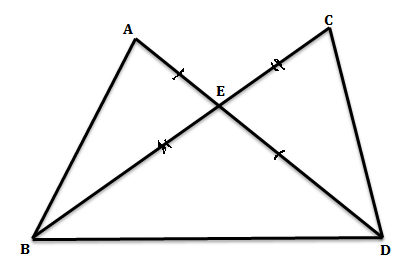
In the given figure AE=DE, CE=BE, then prove that AB =CD .


Answer
598.2k+ views
Hint: CPCT stands for Corresponding Parts of Congruent Triangles. CPCT theorem states that if two or more triangles which are congruent to each other are taken then the corresponding angles and the sides of the triangles are also congruent to each other.
Complete step by step answer:
Given that AE=DE and CE=BE
To Prove that AB =CD
Since BC and AD are two straight lines and the sum of straight angles is 180 degrees.
$\angle AEB+\angle AEC=180..............(1)$
$\angle CED+\angle AEC=180.............(2)$
From the equation (1) and equation (2), we get
$\angle AEB+\angle AEC=\angle CED+\angle AEC$
Since $\angle AEC$ is common on both side, then we can say that
\[\angle AEB=\angle CED................(3)\]
Now In $\Delta AEB$ and $\Delta DEC$
It is given that AE = DE
From the equation (3), \[\angle AEB=\angle CED\]
Also, it is given that CE = BE
So, by using S.A.S. congruence property, SAS states that if any two sides and angles included between the sides of one triangle are equivalent to the corresponding two sides and the angle between the sides of the second triangle.
$\Delta AEB\cong \Delta DEC$
Therefore AB = CD (By corresponding part of congruence triangle)
AB = CD Hence Proved.
Note: You might get confused between RHS and SAS. The main difference between RHS and SAS is that RHS is applicable only in right angled triangles whereas SAS can be applicable to any given triangle. In RHS the angle is always of measure 90 degree whereas in SAS the angle is always the included angle between two sides.
Complete step by step answer:
Given that AE=DE and CE=BE
To Prove that AB =CD
Since BC and AD are two straight lines and the sum of straight angles is 180 degrees.
$\angle AEB+\angle AEC=180..............(1)$
$\angle CED+\angle AEC=180.............(2)$
From the equation (1) and equation (2), we get
$\angle AEB+\angle AEC=\angle CED+\angle AEC$
Since $\angle AEC$ is common on both side, then we can say that
\[\angle AEB=\angle CED................(3)\]
Now In $\Delta AEB$ and $\Delta DEC$
It is given that AE = DE
From the equation (3), \[\angle AEB=\angle CED\]
Also, it is given that CE = BE
So, by using S.A.S. congruence property, SAS states that if any two sides and angles included between the sides of one triangle are equivalent to the corresponding two sides and the angle between the sides of the second triangle.
$\Delta AEB\cong \Delta DEC$
Therefore AB = CD (By corresponding part of congruence triangle)
AB = CD Hence Proved.
Note: You might get confused between RHS and SAS. The main difference between RHS and SAS is that RHS is applicable only in right angled triangles whereas SAS can be applicable to any given triangle. In RHS the angle is always of measure 90 degree whereas in SAS the angle is always the included angle between two sides.
Recently Updated Pages
Two men on either side of the cliff 90m height observe class 10 maths CBSE

What happens to glucose which enters nephron along class 10 biology CBSE

Cutting of the Chinese melon means A The business and class 10 social science CBSE

Write a dialogue with at least ten utterances between class 10 english CBSE

Show an aquatic food chain using the following organisms class 10 biology CBSE

A circle is inscribed in an equilateral triangle and class 10 maths CBSE

Trending doubts
Why is there a time difference of about 5 hours between class 10 social science CBSE

Write a letter to the principal requesting him to grant class 10 english CBSE

What is the median of the first 10 natural numbers class 10 maths CBSE

The Equation xxx + 2 is Satisfied when x is Equal to Class 10 Maths

Which of the following does not have a fundamental class 10 physics CBSE

State and prove converse of BPT Basic Proportionality class 10 maths CBSE




